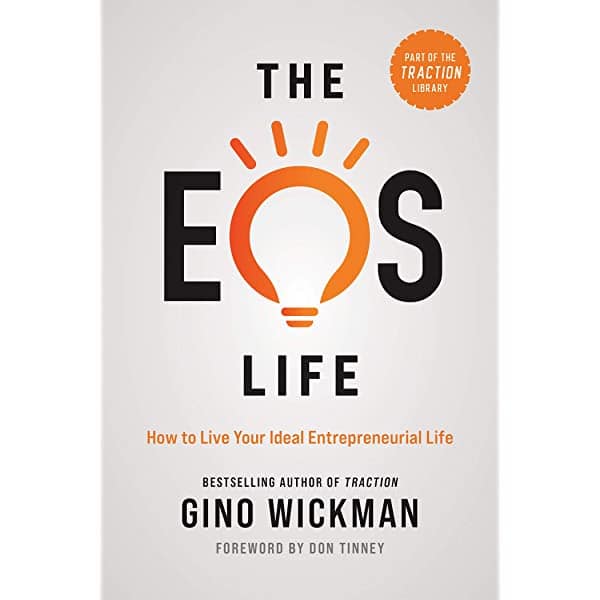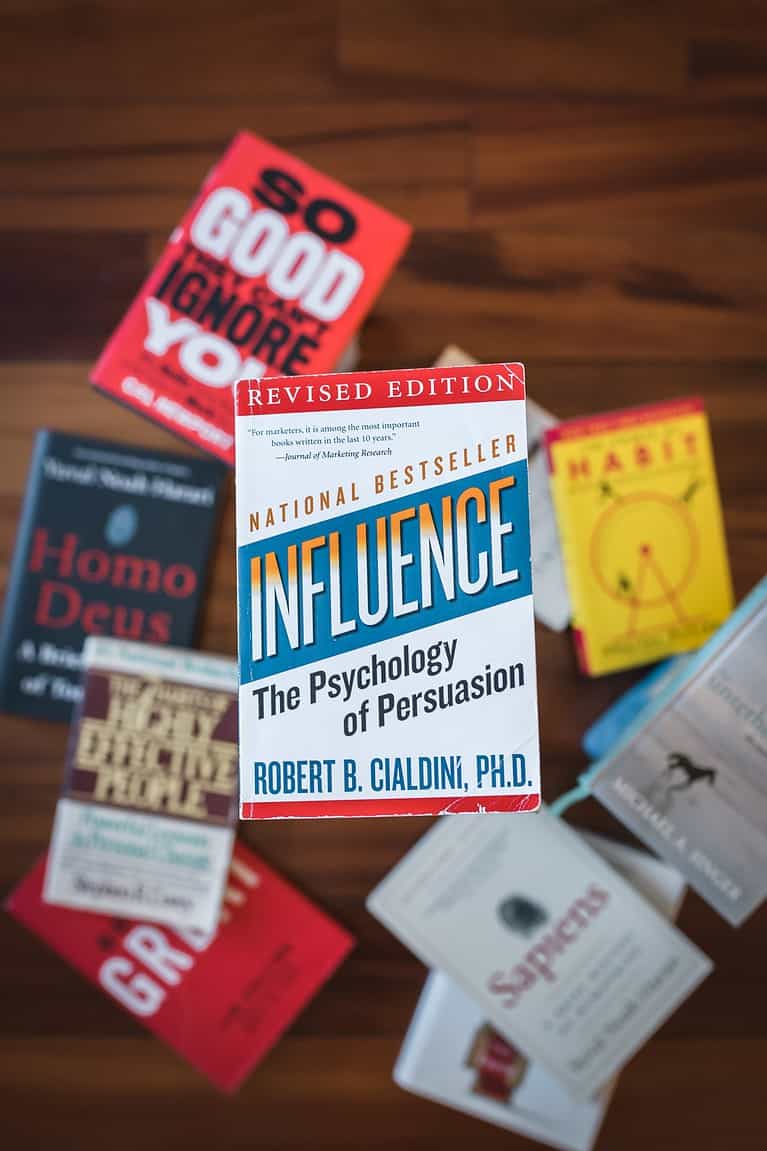The EOS Life by Gino Wickman | Book Summary
Entrepreneurial Operating System (EOS) helps entrepreneurs get everything they want from their business. However, EOS was more than a business system, as the author of The EOS Life, Gino Wickman, incorporated it into creating a more meaningful life.
“You deserve to live your ideal life. Sadly, most entrepreneurs and leaders don’t. This book was written to change that.” Gino Wickman became consumed by his business and later realized that he was nowhere close to living his ideal life. Thus, Gino Wickman wrote the book, The EOS Life, “to give you everything you need to live your ideal life:”
The EOS Life – the ideal entrepreneurial life philosophy to be:
- “Doing what you love
- With people you love
- Making a huge difference
- Being compensated appropriately
- With time for other passions”
Buy The EOS Life on Amazon

The EOS Life by Gino Wickman
How to Live Your Ideal Entrepreneurial Life
EOS has specific tools, disciplines, and philosophies, and Gino Wickman dives into the relevant tools in each chapter of The EOS Life. Then, he shows you how the tools affect your personal life, so you can work toward living your ideal life. To learn more about EOS, check out the book, Traction by Gino Wickman (book summary).
Each chapter has journal prompts, so you should use your own journal, write in the book notes, or get a planner from The EOS Life website.
Download the PDF Book Summary for The EOS Life by Gino Wickman
Chapter 1: Doing What You Love
“Where your talents and the needs of the world cross, lies your calling, vocation, purpose.” —Aristotle
You need to determine what you love doing and then spend all your time working on it:
Doing What You Love – “spending your days doing things you love and are great at – things you do that give you energy and that you’re passionate about”
“What kind of work do you love to do?”
- Spend five minutes thinking about this question.
- Write down in your journal what comes to mind.
- Rate yourself (scale from 1 to 10) regarding how much of your working time is spent doing what you love.
In The EOS Life, Gino Wickman says that many entrepreneurs build companies through brute force and sheer will. As a result, the business grows, but they end up getting stuck in the details, doing things they dislike and becoming burned out. Thus, “you must avoid trying to be all things to all people, trying to do it all, trying to be good at everything.”
Delegate and Elevate
This EOS tool helps you clarify and identify the activities you love doing and those you must delegate to free up time. First, list all the tasks that you do at work. Then, in your journal, draw the four quadrants to place into each business task deciding whether you:
- Love Doing It and are Great at Doing It (top left);
- Like Doing It and are Good are Doing It (top right);
- Don’t Like Doing It and are Good at Doing It (bottom left); and
- Don’t Like Don’t It and are Not Good at It (bottom right).
There are many tasks that you should not do, so “delegate” all tasks in the bottom two quadrants and “elevate” to only doing jobs within the top two quadrants. If a task does not add value, just delete it instead of delegating.
Every quarter, review your tasks and try to delegate at least one task. After delegating all tasks in the bottom half, move to delegate those tasks in the top right quadrant. The process of delegation is an incremental journey. When you only work in the top left quadrant, you will do what you love and be more free, happy, and more productive.
The Accountability Chart
This EOS tool helps you organize your company to have the right structure, which will:
- Have three significant functions: Sales and Marketing, Operations, and Finance and Administration.
- Identify and clarify roles with five to seven responsibilities so that your people are held accountable.
- Help people understand who they report to and communicate with to get their work done.
- Facilitate efficient decision-making and problem-solving.
Once your Accountability Chart is complete, each function with its roles is a “seat” that needs to be filled. Regarding The EOS Life, Gino Wickman says that the chart “has just one goal: the seat you occupy on the chart must reflect your personal sweet spot.”
Chapter 2: With People You Love
“You will either look back in life and say I wish I had, or I’m glad I did.” — Zig Ziglar
You have the choice to spend your life surrounded by people who drain your energy, complain often, and are no fun. Or you can surround yourself with those who you love:
With People You Love – “being with people you really love being around, who are enjoyable and uplifting, and with whom you can be your authentic self”
“Who are the people you love to work with?”
- Spend five minutes thinking about this question.
- Write down in your journal what comes to mind.
- Rate yourself (scale from 1 to 10) regarding how much of your working time is spent with people that you love working with.
“When your leadership team meets every week, the meeting should be filled with laughter, intense debate, passionate discussion, high trust, and respect. You should look forward to working together and seeing each other.” If you dislike meetings or try to avoid your coworkers, Gino Wickman states that you are not living the EOS Life, and that’s an issue.
The People Analyzer
This EOS tool helps you surround yourself with the people you love by identifying if someone fits your culture and is in the right seat. First, you should work with your leadership team to discover your core values. Then, evaluate each person’s fit to your company’s core values using the following rating system:
- Plus (+): Rating for one who mainly embodies the specific Core Value.
- Plus/Minus (+/-): Rating for one who partially represents the specific Core Value.
- Minus (-): Rating for one who rarely embodies the specific Core Value.
Establish minimum standards, and then you should always hire, fire, review, and reward your people with your core values in mind. Many people will turnover in your business so that you can replace them with a better fit. As a visionary, you may need to replace everyone in your leadership team. After using this tool, you will be happier and surrounded by the people you love.
Life is Short
You are not stuck with someone for life. It is common for business partners not to get along due to different core values. When there is tension in a business partnership that is irreconcilable, do the following:
- Understand that “Life is too short.”
- Imagine living in a decade from now if nothing changes.
- Ask yourself, “Is it worth living this way?”
Typically, these steps provide clarity with a better life without the other person. The newfound freedom after a business breakup results in happiness.
Expand Your Circle
Extend your core value alignment outside your business to ideally include your clients, customers, and vendors. If you can, try to focus more on your core value-aligned clients and fire the worst ones.
“Show me your friends, and I’ll show you your future.” Further extend your circle by seeking core values fit with your family, friends, and acquaintances. You should recognize that your personal and professional core values may vary.
Download the PDF Book Summary for The EOS Life by Gino Wickman
Chapter 3: Making a Huge Difference
“The people who are crazy enough to think they can change the world are the ones who do.” —Steve Jobs
In The EOS Life, Gino Wickman states that you get to decide the difference that you want to make:
Making a Huge Difference – “making a huge impact and leaving a legacy whether it’s with the world, your employees, clients/customers, family, friends or yourself”
“How do you make a difference?”
- Spend five minutes thinking about this question.
- Write down in your journal what comes to mind.
- Rate yourself (scale from 1 to 10) regarding how much of your working time is spent making an impact.
Making a genuine difference can be daunting or uncomfortable. However, you have the opportunity to build a fantastic business that will make a huge difference. Consider the impact that you will make on your employees, customers, clients, and community.
Vision/Traction Organizer (V/TO)
This EOS tool will help you make a massive difference by describing the strategic plan and the vision for where the company is going. The V/TO communicates the vision through the following eight parts:
- Core Values – the 3-7 guiding principles for who you are as an organization that help shape the company culture
- Core Focus – the purpose of why your organization exists and the specific niche that it fits into
- 10-Year Target – the big-picture decade goal based on the vision and core focus
- Marketing Strategy – the plan that consists of your target market, three unique differentiators, a proven process, and a guarantee
- Three-Year Picture – the mid-range goal for where your business will be three years from now
- One-Year Plan – the goal that outlines the 3-7 objectives that your business will accomplish that year
- Quarterly Rocks – the 90-day or 12-week priorities that will help your people move toward the longer-term goals
- Issues List – the company-wide list of problems that will prevent you from reaching your goals
In your V/TO, Discuss the impact that you will make in your industry, people, and clients. Once you and your leadership team create and align on the V/TO, you will be off making a huge difference.
Create More Leaders
The best way to make a difference is to create more leaders. Simon Banks said, “You are not a leader until you have produced a leader—who can produce another leader.” Thus, “you should not consider yourself a true leader until you have mentored and produced a leader that can do the same for someone else.
Chapter 4: Being Compensated Appropriately
“Those who do more than they are paid for will sooner or later be willingly paid for more than they do.” — Napoleon Hill
In The EOS Life, Gino Wickman states that you choose your level of compensation, and it is directly proportional to the value you create:
Being Compensated Appropriately – “making as much money as you want by providing value to others, helping them get what they want”
“Do you feel that you are being compensated appropriately?
How are you adding value for people?
Can you create more value?”
- Spend five minutes thinking about these questions.
- Write down in your journal what comes to mind.
- Rate yourself (scale from 1 to 10) regarding how close you are being compensated what you want.
“It’s a winning philosophical formula: money always follows value. If you do something you are deeply passionate about [or are so good they can’t ignore you], which provides tremendous value and helps enough people, you will earn as much as you want. ”
The EOS tools help create value because they provide the framework for your company to scale and solve problems for other people. When your company grows, you increase your value to the world.
Delegate and Elevate
This EOS tool will help you make more money by using your time for the most valuable activities in your job. Thus, you should focus your time in the top left quadrant Doing What You Love and Are Great At. Every time you delegate tasks and elevate yourself, you provide more value, can do more deep work, and can raise your income.
Download the PDF Book Summary for The EOS Life by Gino Wickman
Chapter 5: With Time for Other Passions
“The difference between successful people and really successful people is that really successful people say no to almost everything.” — Warren Buffett
In The EOS Life, Gino Wickman states that if you work all the time, your life is not at balance. Instead, you should work hard and play hard, having time for other passions:
With Time for Other Passions – “Having time to pursue the other activities you’re passionate about in your personal life”
“What are your passion outside of work?”
- Spend five minutes thinking about these questions.
- Write down in your journal what comes to mind.
- Rate yourself (scale from 1 to 10) regarding how much of your personal time is spent doing what you really enjoy.
If you are so exhausted to enjoy your passions outside work, you are out of balance and will burn out. You need to relax and recharge.
Work/Life Balance: The Misconception
In his book, Off Balance, Matthew Kelley discusses the myth of work-life balance. After interviewing many of the best business leaders, he found that they worked about nine more hours more per week than their counterparts did.
When you are passionate about your work, you enjoy working and can choose how many hours you want to work. There is no required number of hours that you must work. Instead, pick the number of hours per week that “gives you time in your personal life to recharge, have energy, and pursue passions.
The EOS Life Time Management
This EOS tool allows you to have time for other passions by creating a non-negotiable work container. You only have a finite amount of time per week and can decide your work capacity or how many hours you are available to work. Then, you must fit all “your roles, responsibilities, and accountabilities of the job” in that container.
To guard your work capacity, you must say no to things that aren’t worth your time, so you can best use your time. In The EOS Life, Gino Wickman says that “no” is his favorite word. And Warren Buffet has said, “The difference between successful people and really successful people is that really successful person say no to almost everything.”
Spending Your Personal Time
Some people have no personal life: no friends, no hobbies, and are distant from their family. You have two options of how to handle this:
- You deny it, just keep working all day, and pretend that everything is fine.
- You change your personal life by doing some soul-searching, reconnecting with your family and friends, and discovering personal passions.
There are many personal passions to choose from, including travel, outdoor adventuring, gaming, meditation, gardening, working out, and so on. Once you discover them, you will gain freedom from your professional life. In addition, enjoying your passions will provide energy, fulfillment, and growth.
In the EOS Life, Gino Wickman has discussed how he takes a one-month sabbatical from his work every August. His goal is to forget his job and hope that he still loves it when he returns. It can provide a renewed love for your work and can increase creativity and productivity. Also, you can download the Personal and/or Family V/TOs to create a clear plan for your personal and/or family lives.
Chapter 6: Living Your Ideal Life
“Life is a journey, not a destination.” — origin unknown
You should make progress every day toward living The EOS Life, and you just need to set goals for when you are living it. Every quarter, review the five points of The EOS Life:
- Doing what you love
- With people you love
- Making a huge difference
- Being compensated appropriately
- With time for other passions
EOS recommends that all leaders take Clarity Breaks, which is time spent working on the business and yourself. Most leaders choose to take one Clarity Break per week, but it is up to you. During the break, you can review your EOS Life journal, do a personal checkup, delegate tasks, or incorporate another personal passion.
In your journal, aggregate all the ratings for each of the five points for 50 total points. The goal is to make constant improvement and strive to 10’s in all categories. Gino Wickman states that scoring above eight or 80% means you are living the EOS Life. Then, write down the data by which you will be living the EOS Life.
10 Disciplines for Managing and Maximizing Your Energy
At the end of The EOS Life, Gino Wickman includes a bonus mini-book with ten disciplines to manage and maximize your energy. He has been living according to these disciplines for more than 20 years and has achieved great success.
- 10-Year Thinking: Change your mindset to think in terms of 10-year time horizons to help you align your decisions and actions with your timeline. Visualize and write down the most important thing you want to achieve in 10 years.
- Take Time Off: Make a habit of carving out personal time away from work to relax and recharge. This escape will allow you to come back to work with passion, creativity, and productivity. Commit to a specific number of “days off” to take during the year.
- Know Thyself: Understand your strengths, weaknesses, personality, and modus operandi. You can use personality tests, get therapy, and reach out to friends or family. Commit to taking one action to know yourself better.
- Be Still: Start your day by spending 10 to 30 minutes in stillness through meditation, prayer, silence, or deep breathing. These actions can get you out of your head and into your body to be grounded and gain clarity.
- Know Your 100%: Determine your work container or the exact number of hours of work per week and weeks of work per year. From there, you can figure out the ideal time to wake up, work, and finish working to maintain peak energy.
- Say No … Often: It is vital to say no, even though it is uncomfortable, to best use your personal resources. Write down at least one thing that you should have said no to, and then commit to at least saying no once per week.
- Don’t Do $25-an-Hour Work: Increase your hourly rate and delegate all the administrative $ 25-per-hour tasks from your life. Use the Delegate and Elevate tool to eliminate emails, calendar management, travel planning, and follow-up.
- Prepare Every Night: Before sleeping, create a plan on paper or digitally for your next day, both personally and professionally. You will sleep better and wake up full of creativity and ready to go.
- Put Everything in One Place: Get everything out of your head, including commitments, ideas, and thoughts. Write them down on paper or digitally, and later organize your daily notes at the end of the day.
- Be Humble: On the scale from arrogant to humble, strive for humility. “Humility is not thinking less of yourself, it is thinking of yourself less.” List the five most influential people in your life and reach out to get feedback on your humility.
Download the PDF Book Summary for The EOS Life by Gino Wickman
Next Steps: Check Out The EOS Life by Gino Wickman
In the EOS Life, Gino Wickman discusses how to live by the EOS tools to create a more meaningful life. He says that you should be doing what you love, with people you love, making a huge difference, being compensated appropriately, with time for other passions.” I hope this blog post has inspired you to get your copy of The EOS Life or check out the rest of the EOS library:
- Traction (book summary): Helps entrepreneurs implement EOS and the Six Key Components to gain traction and grow their businesses.
- Get a Grip (book summary): Tells a fictional business fable about an entrepreneurial company hitting the ceiling. In response, the company’s leadership implements EOS for success.
- Rocket Fuel (book summary): Provides a guide for the integral relationship between a Visionary and an Integrator.
- How to Be a Great Boss (book summary): Helps leaders and managers at all levels of an organization get the most from their people.
- What the Heck is EOS? (book summary): Provide a complete and simplified guide on the EOS process and tools for your employees.
- Process (book summary): Helps you document, simply, and package your core processes such that they are followed by all in your organization.
- Entrepreneurial Leap (book summary): Helps you determine if you are an Entrepreneur-in-the-making, take the Entrepreneurial Leap, and become an entrepreneur.







